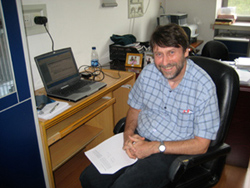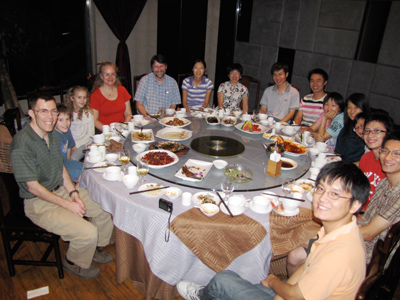 On Tuesday 17th August Dr. Tony Jackson from the University of Cambridge gave a very informative guest lecture on Proteomic and Cell Biological Approaches to the Study of Clathrin in Membrane Trafficking. Tony is a Senior Lecturer in the Department of Biochemistry at the University of Cambridge, UK, and has been visiting Dr Sarah Perrett’s lab since mid-July on a two-month fellowship as part of the “CAS Senior International Scientists Visiting Professorships Program”.
On Tuesday 17th August Dr. Tony Jackson from the University of Cambridge gave a very informative guest lecture on Proteomic and Cell Biological Approaches to the Study of Clathrin in Membrane Trafficking. Tony is a Senior Lecturer in the Department of Biochemistry at the University of Cambridge, UK, and has been visiting Dr Sarah Perrett’s lab since mid-July on a two-month fellowship as part of the “CAS Senior International Scientists Visiting Professorships Program”.
After a very informative introduction to clathrin and its role in membrane trafficking, Dr Jackson went on to describe work published by his lab last year in Molecular and Cellular Proteomics (1). One of the major challenges in eukaryotic cell biology is to understand the roles of individual proteins and their subcellular locations. Tony’s group has taken a proteomics’ approach to looking at this question and the role clathrin plays in receptor-mediated endocytosis. He described how they analysed organelle proteins from the major organelles of the chicken DT40 lymphocyte cell line using an approach called “Localization of organelle proteins by isotope tagging” or LOPIT (this work was done in collaboration with the Cambridge Center for Proteomics). The DT40 lymphocyte cell line was of particular interest since it has become an important research tool due to the ease with which it can be used to generate gene knockouts.  Dr Jackson’s lab identified 1090 proteins in preparations enriched for integral membrane or soluble and peripherally associated proteins and localized 223 proteins to the endoplasmic reticulum, Golgi, lysosome, mitochondrion, or plasma membrane by matching their density gradient distributions to those of known organelle residents. One unexpected finding was that a high proportion of proteins within the secretory and endocytic pathways are not uniquely localized to a single organelle, indicating that at steady state a substantial fraction of proteins are in transit between compartments, and emphasizing the dynamic steady-state nature of intracellular compartments in eukaryotic cells. In subsequent research Tony’s group used this proteomic profile to compare protein expression in a clathrin-expressing wild-type DT40 cell line with that in a clathrin-knockout cell line. Their main findings were that contrary to expectations there are few major differences between cells with or without clathrin expression. Ten proteins increased their presence at the plasma membrane, while 68 proteins moved off the plasma membrane in the absence of clathrin.
Dr Jackson’s lab identified 1090 proteins in preparations enriched for integral membrane or soluble and peripherally associated proteins and localized 223 proteins to the endoplasmic reticulum, Golgi, lysosome, mitochondrion, or plasma membrane by matching their density gradient distributions to those of known organelle residents. One unexpected finding was that a high proportion of proteins within the secretory and endocytic pathways are not uniquely localized to a single organelle, indicating that at steady state a substantial fraction of proteins are in transit between compartments, and emphasizing the dynamic steady-state nature of intracellular compartments in eukaryotic cells. In subsequent research Tony’s group used this proteomic profile to compare protein expression in a clathrin-expressing wild-type DT40 cell line with that in a clathrin-knockout cell line. Their main findings were that contrary to expectations there are few major differences between cells with or without clathrin expression. Ten proteins increased their presence at the plasma membrane, while 68 proteins moved off the plasma membrane in the absence of clathrin.
The collaboration between Professor Perrett’s and Dr Jackson’s groups began several years ago with the visit of Chen Zhang to Dr Jackson’s Cambridge lab to study whether URE2 is taken up by cells via a clathrin-dependent mechanism. Professor Perrett presented Tony with a CAS Visiting Professor’s certificate marking his visit to IBP and thanked him for this contribution to their collaborative research. Both scientists expressed their desire to develop further collaborative links between their labs in the future.

1. Hall SL, Hester S, Griffin JL, Lilley KS, Jackson AP. (2009) The organelle proteome of the DT40 lymphocyte cell line. Mol Cell Proteomics 8:1295-305